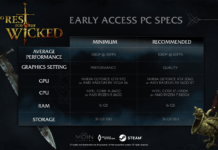WASHINGTON ? While top Marine leaders watch as workers construct a state-of-the-art war-gaming center at Marine Corps Base Quantico, Virginia, war-gaming in multiple forms proliferates across the force.
That’s coming to Marines of all ranks and billets through exercises large and small, board games and advance artificial intelligence options that are being adapted for future use at the unit level.
Those were some of the items presented Wednesday by Col. George Schreffler, director of the war-gaming division at Marine Corps Warfighting Lab, here at the 2022 Modern Day Marine expo in Washington.
If a Marine’s job is touched by Force Design 2030, and all Marines’ jobs are being affected by that guiding document, then war-gaming had something to do with how the service made that decision and likely future decisions.
For example, in the recently released 2022 update to force design, the document notes that “extensive wargaming” in the form of Expeditionary Warrior 21 informed the service’s distributed maritime logistics operations concept now being developed with the Navy. That game and another called “Enigma” tested concepts for operations in the information and competition below the level of armed conflict, also called “gray zone” operations.
The data fed into a soon-to-publish Marine Corps Doctrinal Publication 8, “Information,” according to the force design update.
The center will bring together the staff and visiting leaders in one location with advanced technology to double the number of war-games the force can conduct in a year.
Schreffler said the center will “increase the realism of the player experience,” and “significantly increase the amount of data” able to be put into the scenarios. Those two factors alone will “enable a more rigorous analysis” of war-game results and deliver “better and potentially more concrete insights from war games.”
Lastly, and perhaps most important, Schreffler and others see the center as providing a backing to “produce more defendable positions to support service level decisions” on force design and development.
That’s key as Marine Corps leadership has see public criticism of some of the Force Design 2030 changes, such as eliminating tanks, reducing conventional artillery and experiments that could fundamentally alter the size and composition of the infantry.
This is an example of a life-like miniature model of a war zone to help war-gamers have the best training available today. (Chavonne Ford/Marine Corps)
The center was first announced at the 2017 Modern Day Marine exposition by then-Commandant Gen. Robert Neller.
Neller had said he wanted a kind of “holodeck” for Marine war-gaming, a nod to the Star Trek technology that allowed character Capt. James T. Kirk to step into a virtual reality scenario and work through tactical or strategic problems.
The aim at that time was to have a center that could support 20 war-games each year, including two large-scale, 250-participant exercises. Currently, the service runs about a dozen war-games annually, officials said.
Former head of training systems command, then-Col. Walt Yates, told Marine Corps Times that advanced artificial intelligence could allow the center to run a single scenario as many as 1,000 times to better evaluate outcomes and better inform decisions on what to deploy and how to deploy Marine assets.
Marines broke ground on the new war-gaming and analysis center in May 2021. The $79 million center is aimed at figuring out tough problems on what technology, types of formations and even tactics might work in future fights.
Schreffler said the center planned opening is in 2024.
At the time, Assistant Commandant of the Marine Corps Gen. Eric Smith, then a three-star heading Combat Development and Integration, provided tangible reasoning for how the center will affect even the lowest ranks.
“It’s a big deal to those 19-year-olds here, to the ones down at Parris Island or at San Diego, because they do the fighting and the dying,” Smith told Marine Corps Times. “We’re going to make sure they do less of the dying part by what we do here.”
The center’s site is next door to the Marine Corps University and not far from a number of mid- and senior-level Marine office schools and training programs. Its proximity should allow for cross-pollination of ideas from the schools for concept testing at the center.
Former heads of the war-fighting lab and Marine Corps Systems Command also previously told Marine Corps Times that the center will help them back decisions with deeper, evidence-based data, whether that is for unit employment, unit composition or weapons and equipment development and fielding.
But some of the thinking of the center is set to spread across the Corps.
“The vision for the Marine Corps Wargaming and Analysis Center allows us the ability to plug into remote locations and play games using the system or systems that we have in the analysis center,” Schreffler said.
That software is still in the development stage, he said.
“That should be able to allow us to tie into the fleet and elements of training and education command,” he said.
Todd South has written about crime, courts, government and the military for multiple publications since 2004 and was named a 2014 Pulitzer finalist for a co-written project on witness intimidation. Todd is a Marine veteran of the Iraq War.
Marine Corps Times © 2022
Marine Corps Times © 2022











